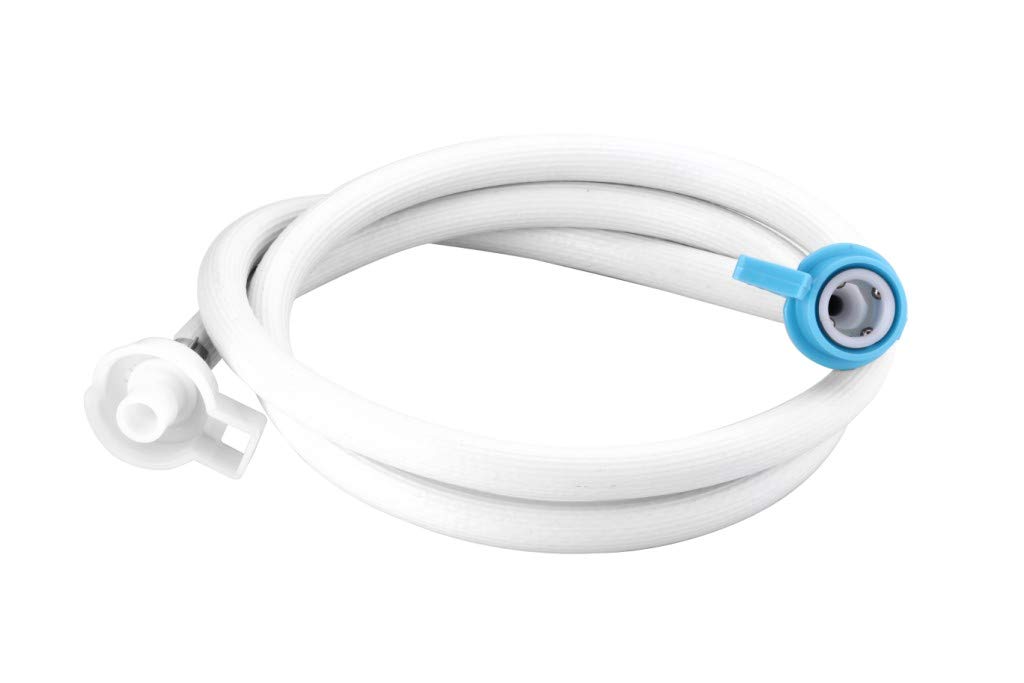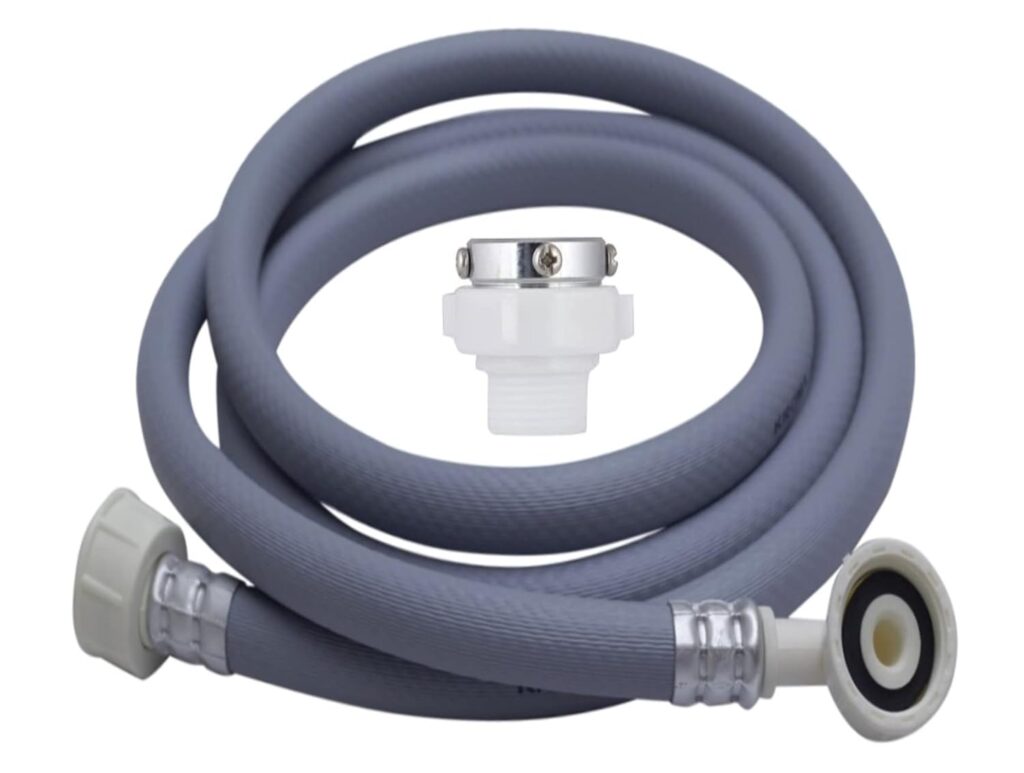Washing machine Inlet pipes have changed the way we wash laundry, bringing ease of use and efficiency. But, in the chaos of detergent and laundry cycle options, a component that is often ignored is the inside pipe, which plays an essential part in the process. The hoses that aren’t noticed may not receive the recognition they deserve but they’re the lifeline for your washer, providing the necessary water required for each wash.
This article will shed some light on the importance of inlet pipes for washing machines and give a thorough review of the top five choices available. Whether you’re a homeowner renting, picking the correct inlet pipe will greatly affect the performance of your washing machine and life span. Let’s examine this crucial part and learn about the top solutions for a smoother washing experience.
Top 5 Best Washing Machine Inlet Pipes
1) Name: Stainless Steel Flexible Washing Machine Inlet Hose

Material Steel: Stainless Steel
The length is 1.5 meters
Features:
- Strong stainless steel construction
- Flexible design that allows for simple installation
- Rust- and corrosion-resistant
- Universal fit for all washing machines.
Pros:
- Long-lasting and durable.
- The design is flexible, making it easy to set up
- Rustand corrosion-resistant
- Universal fit for all washing machines.
Cons:
- It is more costly than other inlet pipes of different types.
Price: 5,665
2) Name: PVC Washing Machine Inlet Hose

Material: PVC
Length: 2 meters
Features:
- Affordable price
- Flexible design that allows for simple installation
- Compatible with the majority of washing machines. Compatible with most washing
Pros:
- Very reasonable
- The design is flexible, making it simple to install
- Compatible with all washing machines.
Cons:
- Not as robust as stainless steel intake pipes
- It can crack or become hard and brittle as time passes
Price: 489
3) Name: Braided Stainless Steel Washing Machine Inlet Hose

Material: Braided stainless steel
The length is 1.8 meters
Features:
- Highly durable braided stainless steel construction
- Flexible design to make it easy to install
- Leak-proof design
- Universally compatible with most washing machines.
Pros:
- Long-lasting and durable.
- Its flexible structure makes it simple to set up
- Leak-proof design
- Universally compatible with the majority of washing machines.
Cons:
- It is more costly than other inlet pipes of different types.
Price: 3,810
4) Name: Extendable Washing Machine Inlet Hose

Material: PVC
The length is 1.5 m (extendable by up to
Features:
- Design extensible for greater flexibility
- Compatible with the majority of washing machines. Compatible with most washing
Pros:
- The additional flexibility makes it suitable for areas that are difficult to reach.
- Compatible with all washing machines.
Cons:
- Not as long-lasting as stainless steel pipes for inlet
- The cracks may break or turn hard and brittle as time passes
Price: 271
5) Name: Universal Washing Machine Inlet Hose

Material: PVC
Length: 2 meters
Features:
- Universally compatible with the majority of washing machines.
- Affordable price
- Installation is simple and easy to do
Pros:
- Universally compatible with the majority of washing machines.
- Affordable price
- Installation is simple and easy to do
Cons:
- Not as long-lasting as stainless steel intake pipes
- It can crack or become hard and brittle as time passes
Price: 699
Installation and Maintenance Tips: Keeping Your Inlet Pipe in Prime Condition
Ensure the proper installation and ongoing maintenance of the washing machine-inlet pipes. This is crucial to ensuring smooth operation and a longer life for your appliance. In this article, we’ll give you important tips and step-by-step directions for correctly installing the inlet pipe for your washing machine, as well as professional guidance on how to properly maintain it.”
Installation Tips:
A. Select the correct place:
- Begin by deciding on the perfect place to put your washer. Make sure that it is near the water source and drain.
- Be sure that the inlet pipe can reach your water source without kinks or tension.
B. Switch off the water supply.
- Before you begin the installation, make sure you switch off the water supply to your residence. This will prevent any leaks that may occur during the installation process.
C. Thread the inlet pipe:
- Connect either end of the pipe to the water valve.
- Make sure it’s secured by using gaskets made of rubber if needed.
D. Join the supply of water
- Attach the opposite end of the pipe to the supply tap.
- Also, you can use seal tape or rubber gaskets to form a watertight seal.
E. Secure the Hose:
- Use brackets or clips to hold the pipe, keeping it from twisting or moving.
F. Connect the supply of water:
- If the pipe for the inlet is fixed and secured then slowly turn off the supply of water to look for leaks.
- Make sure to tighten all connections as needed.
2. Maintenance Guidelines:
A. Regular Inspection:
- Inspect the pipe’s inlet periodically for damage, wear, or cracks. If you find any problems, you need an upgrade.
B. Clean Filters:
- Inlet pipes usually come with filters built-in to remove particles from drinking water sources. Cleaning these filters regularly is essential to ensuring water flow.
C. Check for Kinks:
- Make sure that the pipe inlet isn’t bent or kinked, as this could impede water flow.
D. Prevent Tension:
- Do not put any tension on the inlet pipe, as it could result in leaks or even the pipe becoming damaged over time. Make sure it’s enough to set up.
E. Replace When Necessary:
- Inlet pipes aren’t designed for a lifetime. If you observe any signs of deterioration or leaks, it is recommended to replace them as soon as possible to avoid any water damage to your house.
F. Shut Off Water When Not in Use:
- If your machine is not being used for a prolonged period, switch off your water source to avoid any sudden leaks
Conclusion
In this thorough guide, we’ve explored the essential aspects to consider when choosing the best washing machine inlet pipes and provided useful information for making an informed decision. We’ve highlighted the importance of choosing the best washing machine inlet pipe while giving you a better understanding of the most important features to take into consideration. We’ve also done a thorough analysis of the top five options in the market.
It’s important to remember that a strong and reliable washer’s inlet pipe could protect you from the hassle of leaks and the stress of maintaining problems. If you choose the right pipe, you’re not just ensuring the efficient operation of your machine but also giving yourself peace of mind. Therefore, prior to deciding on your purchase, take the time to evaluate your particular requirements and your washing machine’s needs. You’ll definitely appreciate it.
FA&Q
1) What size is the washing machine inlet hose?
However, certain washing machines might have different inlet hoses. It is essential to read the manual of your washer to find the proper size.
If you’re unsure about the dimensions of your washing machine’s intake pipe, you can check the length of the hose on the end that connects the washing machine. It should measure about 3/4 inch.
It is also possible to purchase an universal washer inlet hose that fits most washing machines.
2) What is an inlet water pipe?
Inlet water pipes are an inlet pipe that allows water to flow through the device or machine. It can be used in a myriad of different applications, including plumbing appliances, machines, and industrial equipment. Water pipes for inlet are usually composed of plastic or metal and are available in a range of lengths and sizes.
3) What is inlet and outlet pipe?
Outlet and inlet pipes are two kinds of pipes used to regulate how fluids flow. Inlet pipes are pipe that allows fluids to enter a system. On the other hand, outlet pipes are those that permit fluid to exit a system.
Read More: Top 5 Best Washing Machine Liquids in 2024 for your Laundry